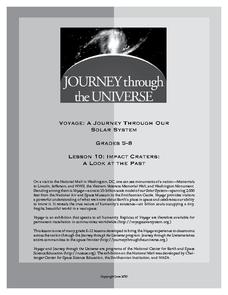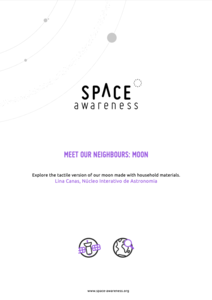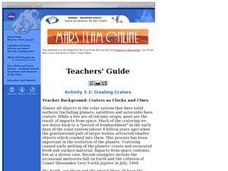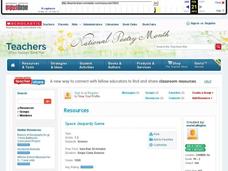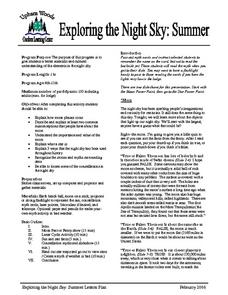Curated OER
once and future MOON
Beyond the phases of the moon, this comprehensive lesson plan covers geologic history and geology. Amateur astronauts examine photos of the lunar landscape, experiment with the creation of craters, and delve into information about the...
Alabama Learning Exchange
The Moon's Craters
Fifth graders investigate the formation and size of impact craters. In small groups, they conduct an experiment that involves dropping marbles into flour and measuring the impact from various heights and discussing their hypothesis and...
MENSA Education & Research Foundation
The Moon: Earth’s Dependable Neighbor
Scholars become experts on the moon, its phases, and craters with a series of lessons, activities, and extension opportunities. Learners' expert level of knowledge includes moon facts, how moon craters are created, the ability to...
Journey Through the Universe
Impact Craters: A Look at the Past
The Galle crater on Mars is also known as the Happy Face crater because of its appearance. First, scholars use pebbles and flour to simulate craters and study their properties. They then apply this knowledge to help decipher the history...
Space Awareness
Meet Our Neighbors: Moon
Since a field trip to the moon isn't possible, bring the moon to young astronomers! Participants use everyday materials to create models of the moon and represent the features on its surface. The materials serve as a tactile as well as a...
Curated OER
Moon: NC Summer Tour Lesson 2007
Students investigate craters and marea. For this crater and marea lesson, students conduct an experiment to create craters. Students participate in a dance activity.
Curated OER
Doin' The Moonwalk
If you are looking for an outstanding lesson on the Moon for your budding astronomers, look no further! This outstanding plan is full of wonderful, meaningful activities for your charges to engage in. Pupils will discover why there are...
University of Colorado
Are All Asteroids' Surfaces the Same Age?
There are more than 600,000 asteroids in our solar system. Pupils analyze images of two asteroids in order to determine if they are the same age. They count craters for each asteroid and compare numbers.
Curated OER
Creating Craters
Students explore parts of an impact crater and compare and contrast craters found in Earth, the Moon, and Mars. Crater formation is modelled and the relationship of mass, velocity, and size of the projectile to the crater formation is...
Curated OER
Lunar Cratering-Probability and Odds
In this lunar cratering worksheet, learners use probability to determine the outcome of coin flipping. They use this to represent the probability that asteroids will strike the moon in already cratered areas.
Curated OER
Blue Moon
Students explore information about the moon. In this trans-disciplinary lesson plan, students first listen to a picture book about the moon, then create an accompanying art project to illustrate a blue moon. Finally, the students write...
Curated OER
Making Impact Craters
Young scholars examine images of Moon craters and speculate about what caused them. They create craters using sand weighted balls. Students measure crater sizes and draw ejection patterns to see what effect size, weight, and velocity...
Curated OER
Lunar Craters
Students explore crater impacts. In this moon crater lesson students evaluate and interpret the physical characteristics of a crater.
Curated OER
Moon Craters Lab
Learners explore characteristics of mass. In this scientific inquiry about mass lesson, students drop rocks of different weights from various heights and record the depth of the "crater" created. Learners record their findings on a...
Curated OER
Space Jeopardy Game
Students explore space. In this space lesson, students analyze the sky and what causes its changes. Students describe the moon patterns and use a model to show changes in its shape. Students also describe the first trip to the moon....
Curated OER
Regolith Formation
Students explain the difference between regolith formation on Earth and the Moon. In this space science lesson, students model the different factors affecting regolith formation on Earth. They identify the different types of weathering.
Curated OER
Impact Craters
Students investigate the factors affecting the size of a crater. In this space science lesson, students collect data from the activity and graph them. They explain how velocity of impact relate to crater size.
Curated OER
Making a Crater
Students examine the characteristics of craters. In this crater lesson, students discover how meteors form craters on planets and moons as they make their own craters and respond to observational questions regarding the...
Curated OER
Moon Observations
Third graders create a model of the moon and use a flashlight to illustrate the various stages of the moon.
Curated OER
Multicultural Sun, Moon, and Star Activities
Students research the multicultural stories and artistic representations of the Sun, Moon, and stars. In this multicultural space lesson, students discuss the symbols and stories for the sun in various cultures. Students construct a...
Curated OER
Exploring the Night Sky: Summer
Learners explain how moon phases occur. They describe and explain at least two common misconceptions that people have about the moon. Students explain what a star is. They explain 3 ways that the night sky has been used throughout history.
Curated OER
TARGET EARTH
Students explore the possibility of an asteroid hitting planet earth. In this planetary instructional activity students complete a lab activity to see the effects of an asteroid hitting earth and compare different craters.
Curated OER
Wax On, Wane Off
Students explore the Earth's only natural sattelite, the moon. They view a demonstration using tennis balls of the waxing crescent moon, waxing gibbous moon and a lunar eclipse.
Curated OER
Craters!
Eighth graders examine the formation of craters. In this craters lesson, 8th graders discover the various energies involved in the formation of a crater, where you can find a crater in the Solar System, and observations of craters on the...





